Risk Management Plan for ERP Project Implementation Failure
VerifiedAdded on 2023/06/14
|34
|6715
|231
Report
AI Summary
This report addresses the critical importance of developing a comprehensive risk management plan, focusing on the scenario of an ERP implementation failure in a multinational company. It highlights the responsibilities of the project manager in allocating resources for various project activities and employs the Failure Mode and Effects Analysis (FMEA) technique for effective risk management. The report details the development of a Terms of Reference (ToR) and risk acceptance criteria tailored to the specific situation. Furthermore, it includes a literature review, identification of project stakeholders, definition of system boundaries, and a discussion of the social benefits of risk exposure. The document also presents different risk assessment methods, risk tolerability criteria, and a quantified Tolerability of Risk (ToR) discussion with relevant measures, concluding with key findings and recommendations.
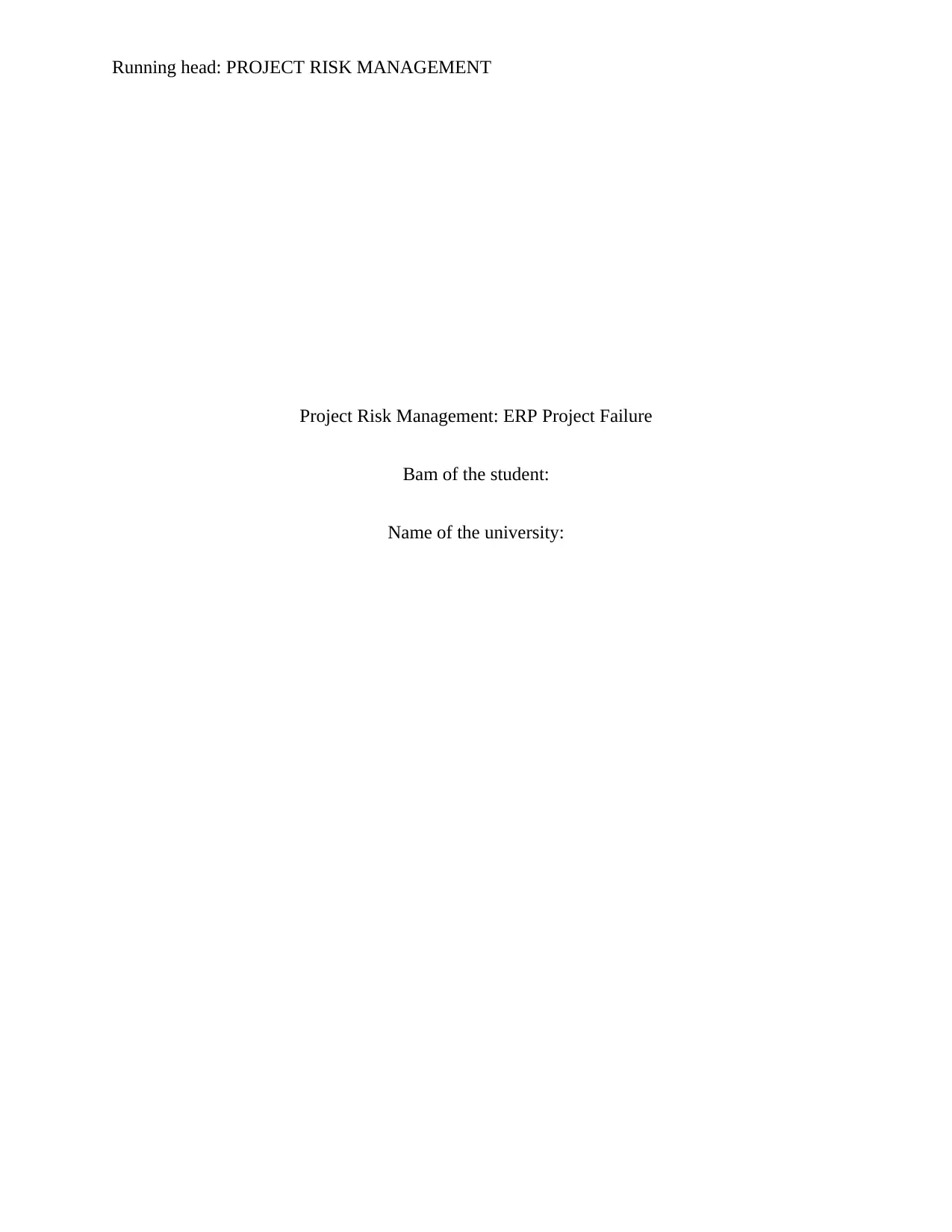
Running head: PROJECT RISK MANAGEMENT
Project Risk Management: ERP Project Failure
Bam of the student:
Name of the university:
Project Risk Management: ERP Project Failure
Bam of the student:
Name of the university:
Paraphrase This Document
Need a fresh take? Get an instant paraphrase of this document with our AI Paraphraser
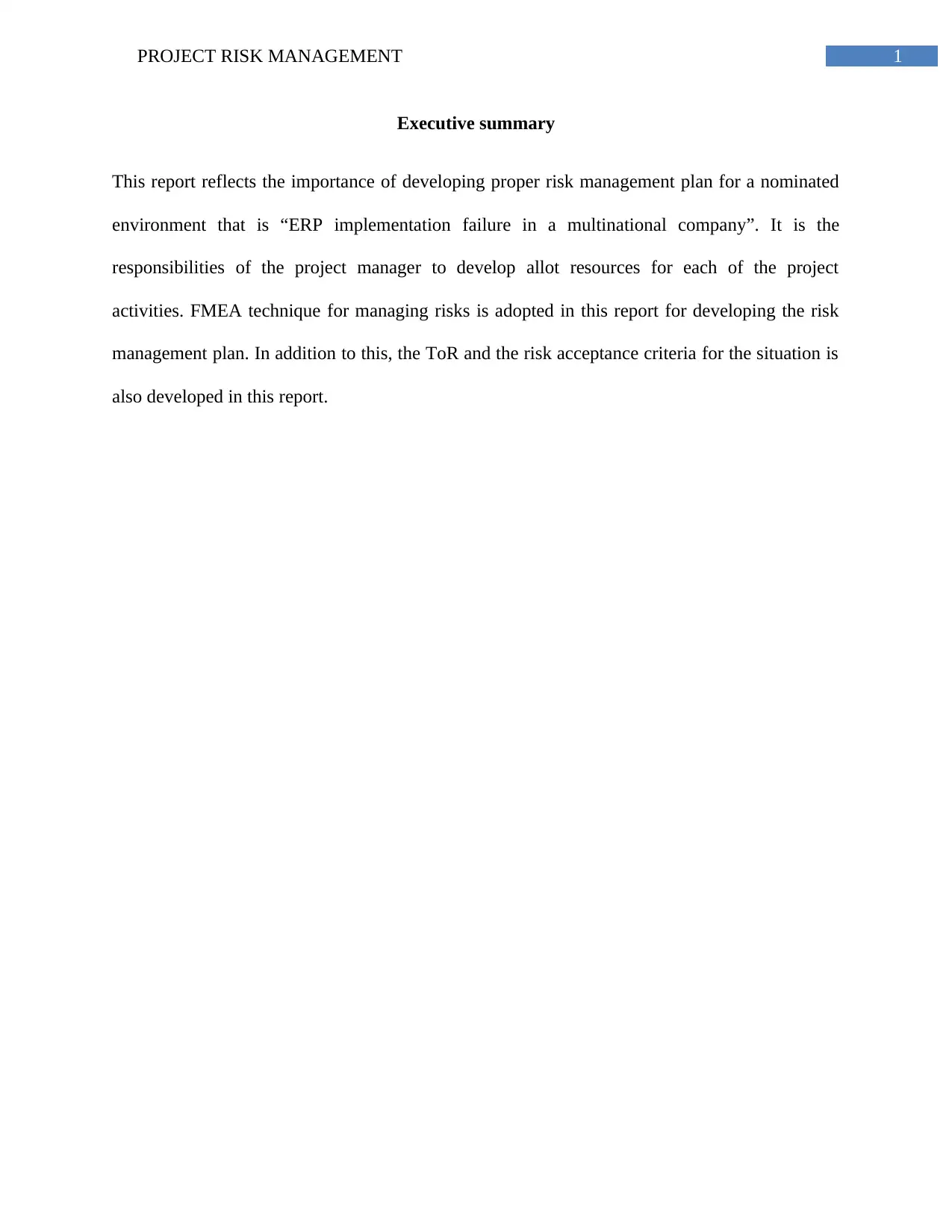
1PROJECT RISK MANAGEMENT
Executive summary
This report reflects the importance of developing proper risk management plan for a nominated
environment that is “ERP implementation failure in a multinational company”. It is the
responsibilities of the project manager to develop allot resources for each of the project
activities. FMEA technique for managing risks is adopted in this report for developing the risk
management plan. In addition to this, the ToR and the risk acceptance criteria for the situation is
also developed in this report.
Executive summary
This report reflects the importance of developing proper risk management plan for a nominated
environment that is “ERP implementation failure in a multinational company”. It is the
responsibilities of the project manager to develop allot resources for each of the project
activities. FMEA technique for managing risks is adopted in this report for developing the risk
management plan. In addition to this, the ToR and the risk acceptance criteria for the situation is
also developed in this report.
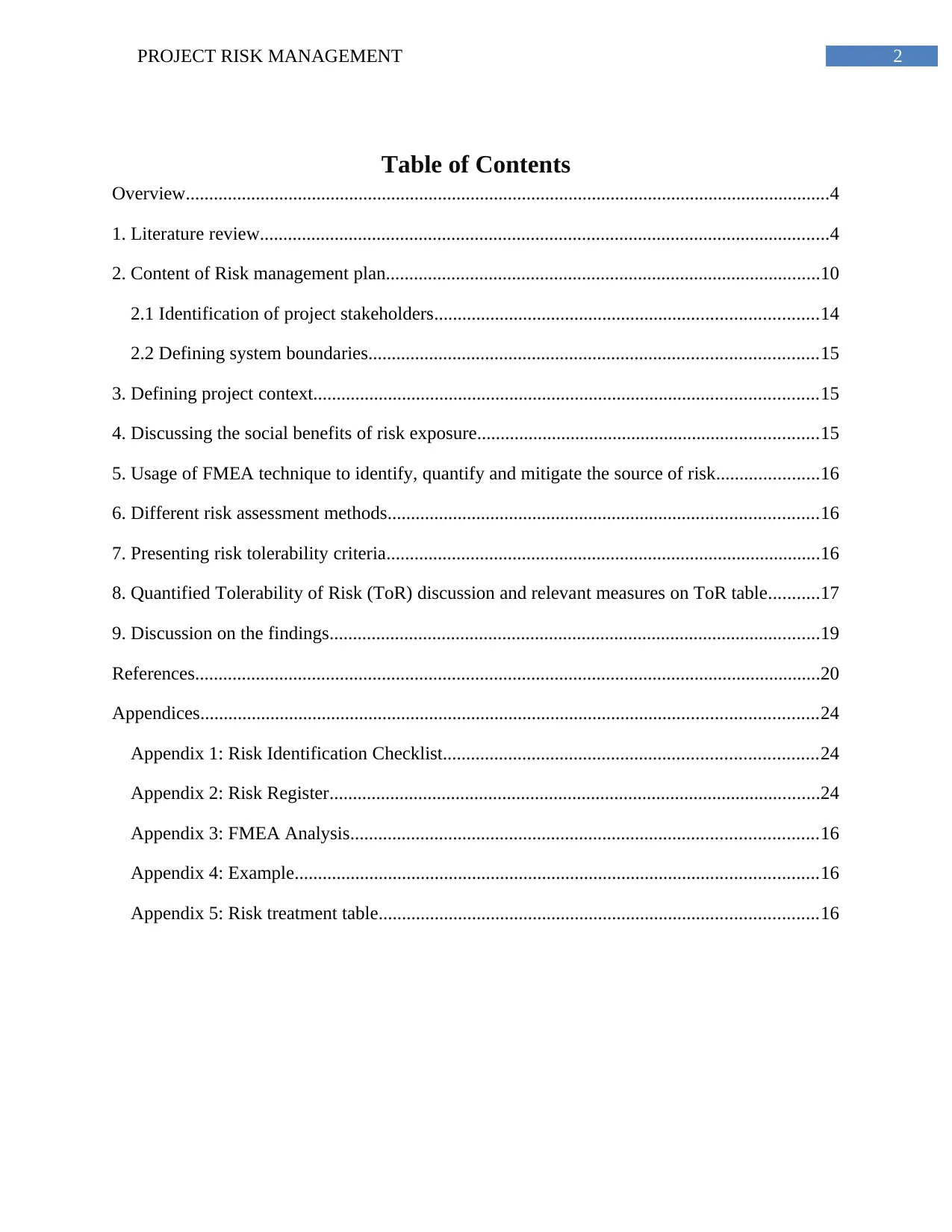
2PROJECT RISK MANAGEMENT
Table of Contents
Overview..........................................................................................................................................4
1. Literature review..........................................................................................................................4
2. Content of Risk management plan.............................................................................................10
2.1 Identification of project stakeholders..................................................................................14
2.2 Defining system boundaries................................................................................................15
3. Defining project context............................................................................................................15
4. Discussing the social benefits of risk exposure.........................................................................15
5. Usage of FMEA technique to identify, quantify and mitigate the source of risk......................16
6. Different risk assessment methods............................................................................................16
7. Presenting risk tolerability criteria.............................................................................................16
8. Quantified Tolerability of Risk (ToR) discussion and relevant measures on ToR table...........17
9. Discussion on the findings.........................................................................................................19
References......................................................................................................................................20
Appendices....................................................................................................................................24
Appendix 1: Risk Identification Checklist................................................................................24
Appendix 2: Risk Register.........................................................................................................24
Appendix 3: FMEA Analysis....................................................................................................16
Appendix 4: Example................................................................................................................16
Appendix 5: Risk treatment table..............................................................................................16
Table of Contents
Overview..........................................................................................................................................4
1. Literature review..........................................................................................................................4
2. Content of Risk management plan.............................................................................................10
2.1 Identification of project stakeholders..................................................................................14
2.2 Defining system boundaries................................................................................................15
3. Defining project context............................................................................................................15
4. Discussing the social benefits of risk exposure.........................................................................15
5. Usage of FMEA technique to identify, quantify and mitigate the source of risk......................16
6. Different risk assessment methods............................................................................................16
7. Presenting risk tolerability criteria.............................................................................................16
8. Quantified Tolerability of Risk (ToR) discussion and relevant measures on ToR table...........17
9. Discussion on the findings.........................................................................................................19
References......................................................................................................................................20
Appendices....................................................................................................................................24
Appendix 1: Risk Identification Checklist................................................................................24
Appendix 2: Risk Register.........................................................................................................24
Appendix 3: FMEA Analysis....................................................................................................16
Appendix 4: Example................................................................................................................16
Appendix 5: Risk treatment table..............................................................................................16
⊘ This is a preview!⊘
Do you want full access?
Subscribe today to unlock all pages.

Trusted by 1+ million students worldwide
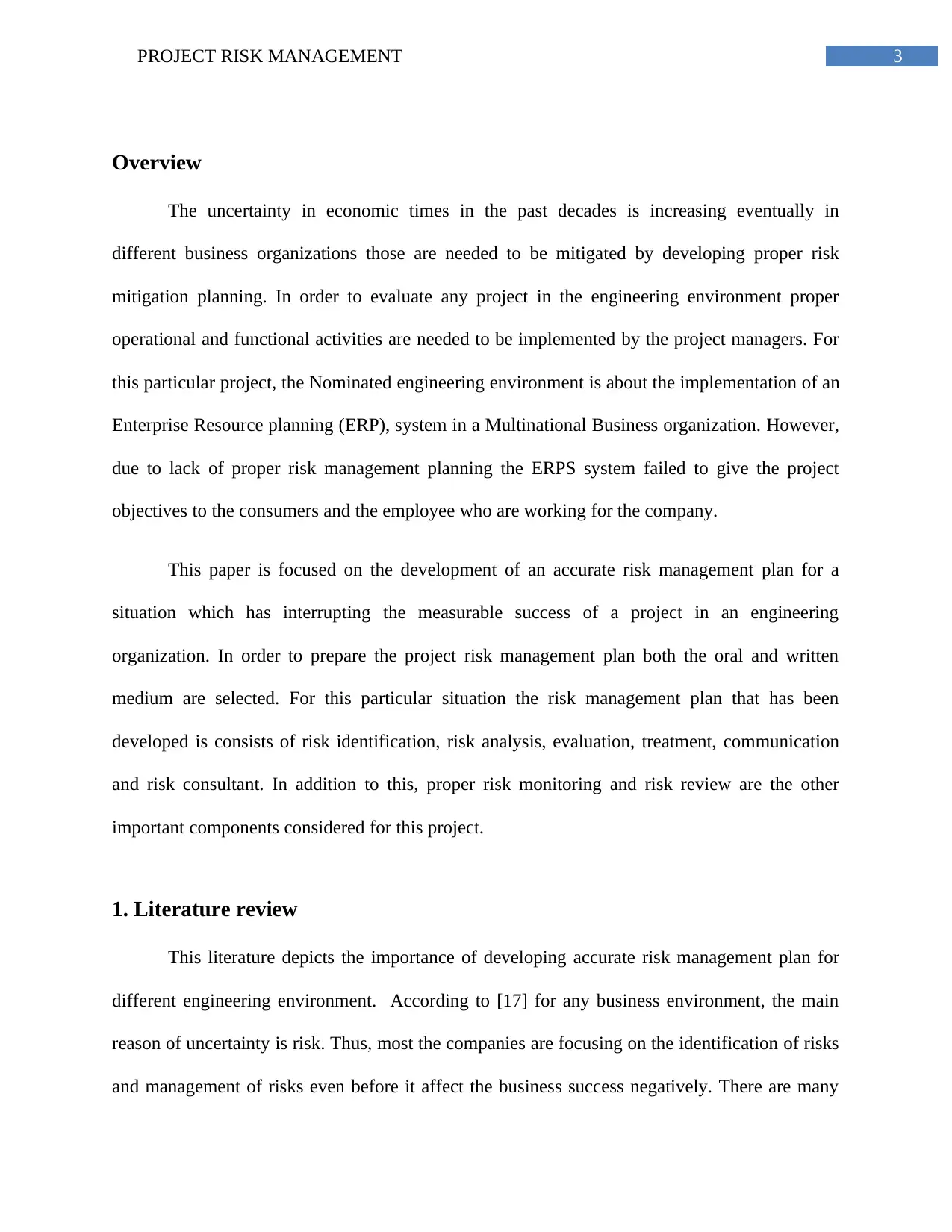
3PROJECT RISK MANAGEMENT
Overview
The uncertainty in economic times in the past decades is increasing eventually in
different business organizations those are needed to be mitigated by developing proper risk
mitigation planning. In order to evaluate any project in the engineering environment proper
operational and functional activities are needed to be implemented by the project managers. For
this particular project, the Nominated engineering environment is about the implementation of an
Enterprise Resource planning (ERP), system in a Multinational Business organization. However,
due to lack of proper risk management planning the ERPS system failed to give the project
objectives to the consumers and the employee who are working for the company.
This paper is focused on the development of an accurate risk management plan for a
situation which has interrupting the measurable success of a project in an engineering
organization. In order to prepare the project risk management plan both the oral and written
medium are selected. For this particular situation the risk management plan that has been
developed is consists of risk identification, risk analysis, evaluation, treatment, communication
and risk consultant. In addition to this, proper risk monitoring and risk review are the other
important components considered for this project.
1. Literature review
This literature depicts the importance of developing accurate risk management plan for
different engineering environment. According to [17] for any business environment, the main
reason of uncertainty is risk. Thus, most the companies are focusing on the identification of risks
and management of risks even before it affect the business success negatively. There are many
Overview
The uncertainty in economic times in the past decades is increasing eventually in
different business organizations those are needed to be mitigated by developing proper risk
mitigation planning. In order to evaluate any project in the engineering environment proper
operational and functional activities are needed to be implemented by the project managers. For
this particular project, the Nominated engineering environment is about the implementation of an
Enterprise Resource planning (ERP), system in a Multinational Business organization. However,
due to lack of proper risk management planning the ERPS system failed to give the project
objectives to the consumers and the employee who are working for the company.
This paper is focused on the development of an accurate risk management plan for a
situation which has interrupting the measurable success of a project in an engineering
organization. In order to prepare the project risk management plan both the oral and written
medium are selected. For this particular situation the risk management plan that has been
developed is consists of risk identification, risk analysis, evaluation, treatment, communication
and risk consultant. In addition to this, proper risk monitoring and risk review are the other
important components considered for this project.
1. Literature review
This literature depicts the importance of developing accurate risk management plan for
different engineering environment. According to [17] for any business environment, the main
reason of uncertainty is risk. Thus, most the companies are focusing on the identification of risks
and management of risks even before it affect the business success negatively. There are many
Paraphrase This Document
Need a fresh take? Get an instant paraphrase of this document with our AI Paraphraser
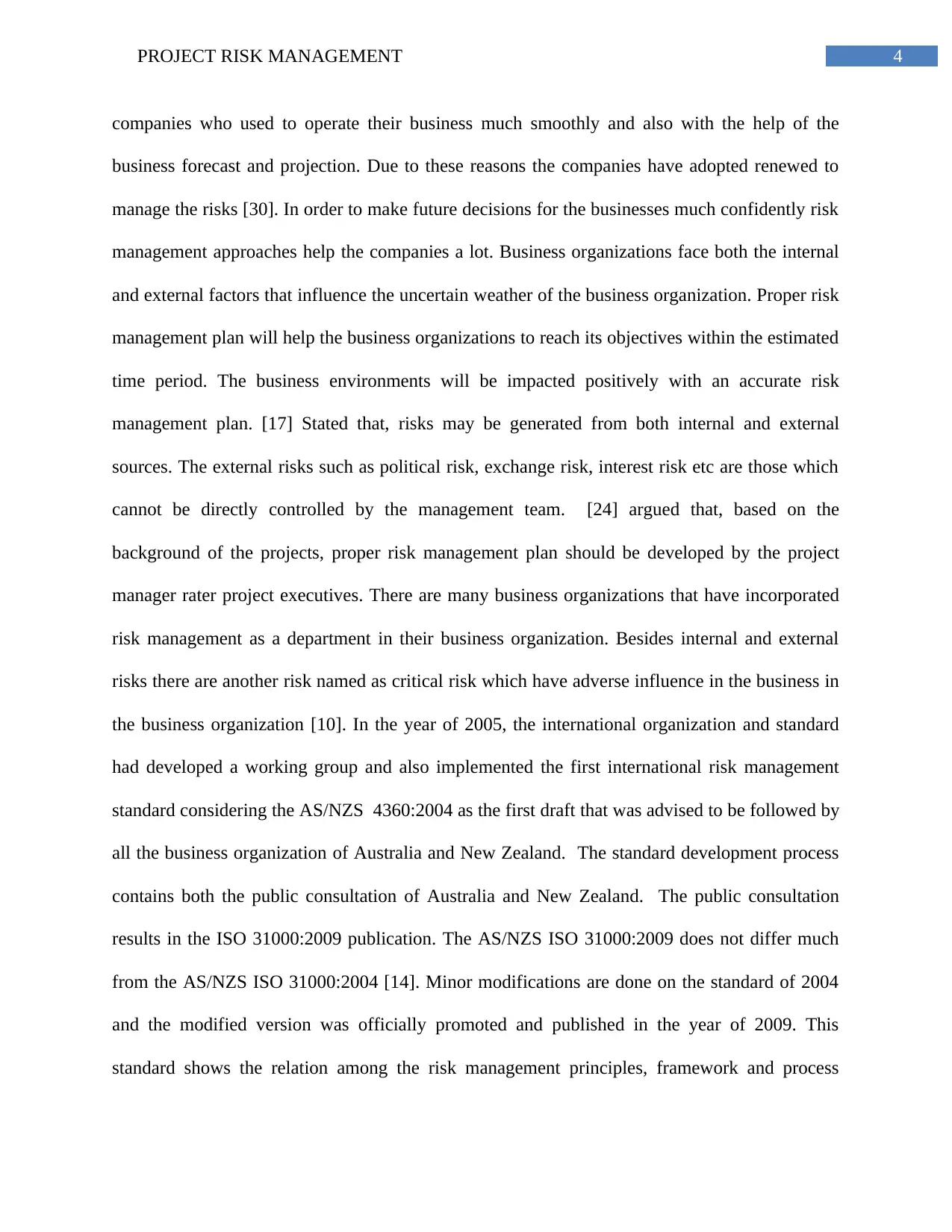
4PROJECT RISK MANAGEMENT
companies who used to operate their business much smoothly and also with the help of the
business forecast and projection. Due to these reasons the companies have adopted renewed to
manage the risks [30]. In order to make future decisions for the businesses much confidently risk
management approaches help the companies a lot. Business organizations face both the internal
and external factors that influence the uncertain weather of the business organization. Proper risk
management plan will help the business organizations to reach its objectives within the estimated
time period. The business environments will be impacted positively with an accurate risk
management plan. [17] Stated that, risks may be generated from both internal and external
sources. The external risks such as political risk, exchange risk, interest risk etc are those which
cannot be directly controlled by the management team. [24] argued that, based on the
background of the projects, proper risk management plan should be developed by the project
manager rater project executives. There are many business organizations that have incorporated
risk management as a department in their business organization. Besides internal and external
risks there are another risk named as critical risk which have adverse influence in the business in
the business organization [10]. In the year of 2005, the international organization and standard
had developed a working group and also implemented the first international risk management
standard considering the AS/NZS 4360:2004 as the first draft that was advised to be followed by
all the business organization of Australia and New Zealand. The standard development process
contains both the public consultation of Australia and New Zealand. The public consultation
results in the ISO 31000:2009 publication. The AS/NZS ISO 31000:2009 does not differ much
from the AS/NZS ISO 31000:2004 [14]. Minor modifications are done on the standard of 2004
and the modified version was officially promoted and published in the year of 2009. This
standard shows the relation among the risk management principles, framework and process
companies who used to operate their business much smoothly and also with the help of the
business forecast and projection. Due to these reasons the companies have adopted renewed to
manage the risks [30]. In order to make future decisions for the businesses much confidently risk
management approaches help the companies a lot. Business organizations face both the internal
and external factors that influence the uncertain weather of the business organization. Proper risk
management plan will help the business organizations to reach its objectives within the estimated
time period. The business environments will be impacted positively with an accurate risk
management plan. [17] Stated that, risks may be generated from both internal and external
sources. The external risks such as political risk, exchange risk, interest risk etc are those which
cannot be directly controlled by the management team. [24] argued that, based on the
background of the projects, proper risk management plan should be developed by the project
manager rater project executives. There are many business organizations that have incorporated
risk management as a department in their business organization. Besides internal and external
risks there are another risk named as critical risk which have adverse influence in the business in
the business organization [10]. In the year of 2005, the international organization and standard
had developed a working group and also implemented the first international risk management
standard considering the AS/NZS 4360:2004 as the first draft that was advised to be followed by
all the business organization of Australia and New Zealand. The standard development process
contains both the public consultation of Australia and New Zealand. The public consultation
results in the ISO 31000:2009 publication. The AS/NZS ISO 31000:2009 does not differ much
from the AS/NZS ISO 31000:2004 [14]. Minor modifications are done on the standard of 2004
and the modified version was officially promoted and published in the year of 2009. This
standard shows the relation among the risk management principles, framework and process
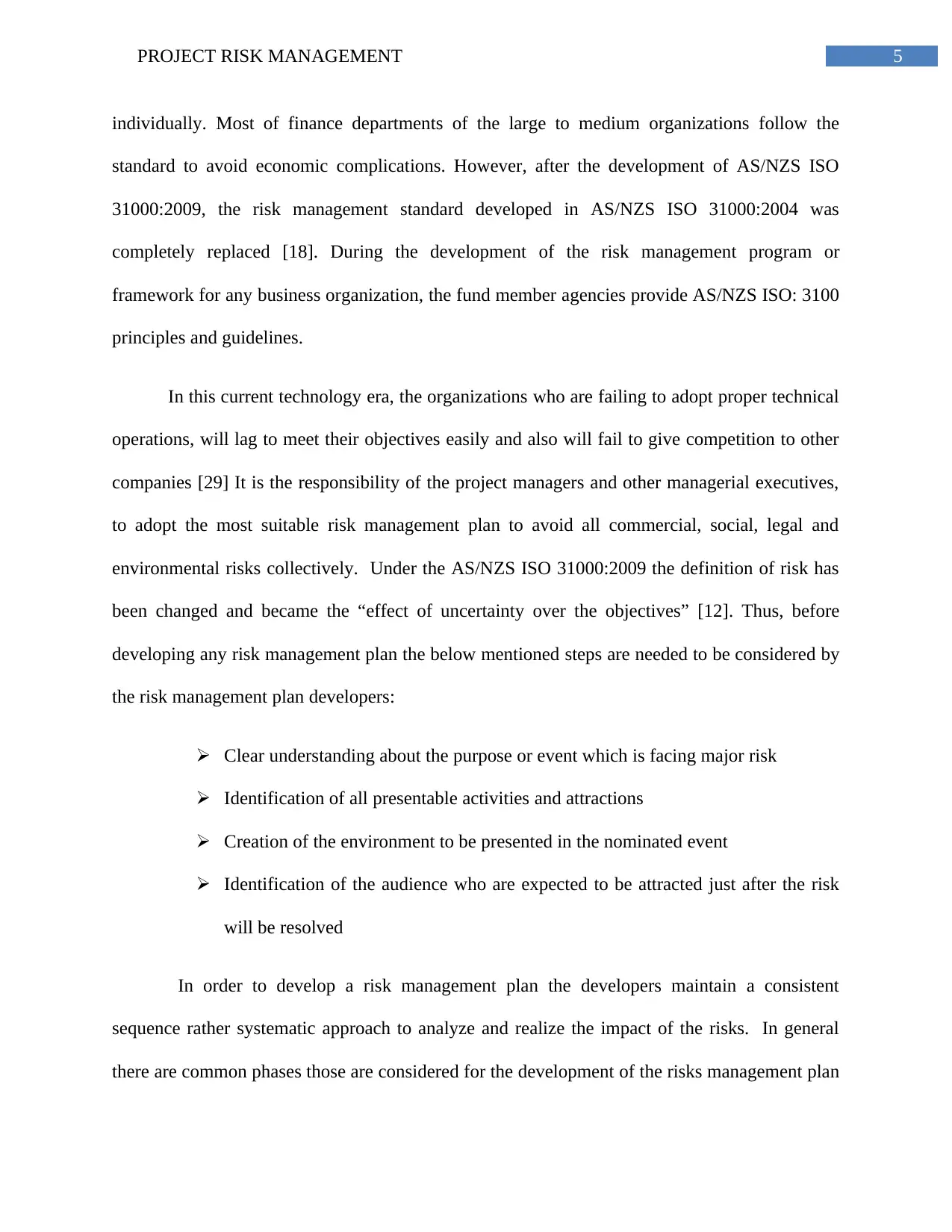
5PROJECT RISK MANAGEMENT
individually. Most of finance departments of the large to medium organizations follow the
standard to avoid economic complications. However, after the development of AS/NZS ISO
31000:2009, the risk management standard developed in AS/NZS ISO 31000:2004 was
completely replaced [18]. During the development of the risk management program or
framework for any business organization, the fund member agencies provide AS/NZS ISO: 3100
principles and guidelines.
In this current technology era, the organizations who are failing to adopt proper technical
operations, will lag to meet their objectives easily and also will fail to give competition to other
companies [29] It is the responsibility of the project managers and other managerial executives,
to adopt the most suitable risk management plan to avoid all commercial, social, legal and
environmental risks collectively. Under the AS/NZS ISO 31000:2009 the definition of risk has
been changed and became the “effect of uncertainty over the objectives” [12]. Thus, before
developing any risk management plan the below mentioned steps are needed to be considered by
the risk management plan developers:
Clear understanding about the purpose or event which is facing major risk
Identification of all presentable activities and attractions
Creation of the environment to be presented in the nominated event
Identification of the audience who are expected to be attracted just after the risk
will be resolved
In order to develop a risk management plan the developers maintain a consistent
sequence rather systematic approach to analyze and realize the impact of the risks. In general
there are common phases those are considered for the development of the risks management plan
individually. Most of finance departments of the large to medium organizations follow the
standard to avoid economic complications. However, after the development of AS/NZS ISO
31000:2009, the risk management standard developed in AS/NZS ISO 31000:2004 was
completely replaced [18]. During the development of the risk management program or
framework for any business organization, the fund member agencies provide AS/NZS ISO: 3100
principles and guidelines.
In this current technology era, the organizations who are failing to adopt proper technical
operations, will lag to meet their objectives easily and also will fail to give competition to other
companies [29] It is the responsibility of the project managers and other managerial executives,
to adopt the most suitable risk management plan to avoid all commercial, social, legal and
environmental risks collectively. Under the AS/NZS ISO 31000:2009 the definition of risk has
been changed and became the “effect of uncertainty over the objectives” [12]. Thus, before
developing any risk management plan the below mentioned steps are needed to be considered by
the risk management plan developers:
Clear understanding about the purpose or event which is facing major risk
Identification of all presentable activities and attractions
Creation of the environment to be presented in the nominated event
Identification of the audience who are expected to be attracted just after the risk
will be resolved
In order to develop a risk management plan the developers maintain a consistent
sequence rather systematic approach to analyze and realize the impact of the risks. In general
there are common phases those are considered for the development of the risks management plan
⊘ This is a preview!⊘
Do you want full access?
Subscribe today to unlock all pages.

Trusted by 1+ million students worldwide
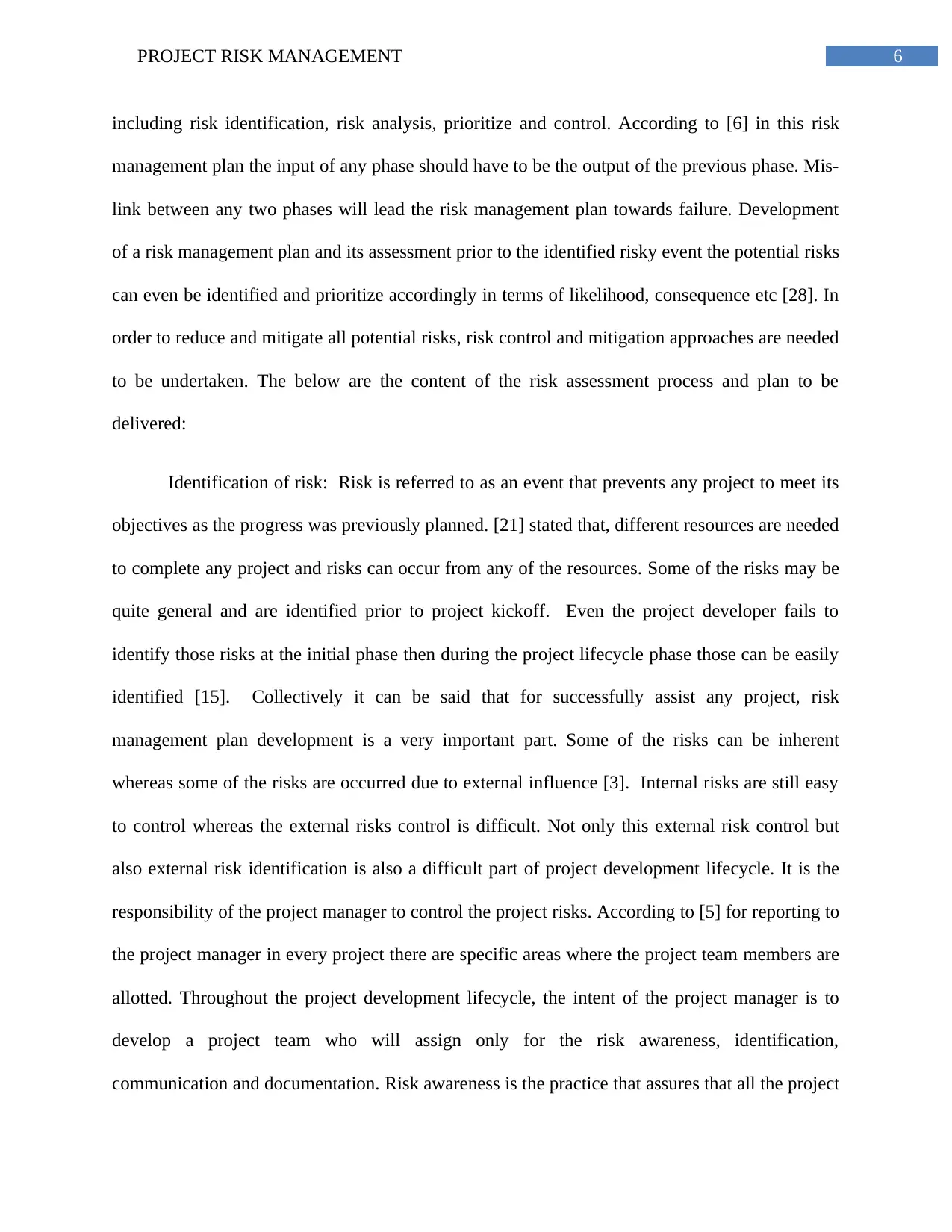
6PROJECT RISK MANAGEMENT
including risk identification, risk analysis, prioritize and control. According to [6] in this risk
management plan the input of any phase should have to be the output of the previous phase. Mis-
link between any two phases will lead the risk management plan towards failure. Development
of a risk management plan and its assessment prior to the identified risky event the potential risks
can even be identified and prioritize accordingly in terms of likelihood, consequence etc [28]. In
order to reduce and mitigate all potential risks, risk control and mitigation approaches are needed
to be undertaken. The below are the content of the risk assessment process and plan to be
delivered:
Identification of risk: Risk is referred to as an event that prevents any project to meet its
objectives as the progress was previously planned. [21] stated that, different resources are needed
to complete any project and risks can occur from any of the resources. Some of the risks may be
quite general and are identified prior to project kickoff. Even the project developer fails to
identify those risks at the initial phase then during the project lifecycle phase those can be easily
identified [15]. Collectively it can be said that for successfully assist any project, risk
management plan development is a very important part. Some of the risks can be inherent
whereas some of the risks are occurred due to external influence [3]. Internal risks are still easy
to control whereas the external risks control is difficult. Not only this external risk control but
also external risk identification is also a difficult part of project development lifecycle. It is the
responsibility of the project manager to control the project risks. According to [5] for reporting to
the project manager in every project there are specific areas where the project team members are
allotted. Throughout the project development lifecycle, the intent of the project manager is to
develop a project team who will assign only for the risk awareness, identification,
communication and documentation. Risk awareness is the practice that assures that all the project
including risk identification, risk analysis, prioritize and control. According to [6] in this risk
management plan the input of any phase should have to be the output of the previous phase. Mis-
link between any two phases will lead the risk management plan towards failure. Development
of a risk management plan and its assessment prior to the identified risky event the potential risks
can even be identified and prioritize accordingly in terms of likelihood, consequence etc [28]. In
order to reduce and mitigate all potential risks, risk control and mitigation approaches are needed
to be undertaken. The below are the content of the risk assessment process and plan to be
delivered:
Identification of risk: Risk is referred to as an event that prevents any project to meet its
objectives as the progress was previously planned. [21] stated that, different resources are needed
to complete any project and risks can occur from any of the resources. Some of the risks may be
quite general and are identified prior to project kickoff. Even the project developer fails to
identify those risks at the initial phase then during the project lifecycle phase those can be easily
identified [15]. Collectively it can be said that for successfully assist any project, risk
management plan development is a very important part. Some of the risks can be inherent
whereas some of the risks are occurred due to external influence [3]. Internal risks are still easy
to control whereas the external risks control is difficult. Not only this external risk control but
also external risk identification is also a difficult part of project development lifecycle. It is the
responsibility of the project manager to control the project risks. According to [5] for reporting to
the project manager in every project there are specific areas where the project team members are
allotted. Throughout the project development lifecycle, the intent of the project manager is to
develop a project team who will assign only for the risk awareness, identification,
communication and documentation. Risk awareness is the practice that assures that all the project
Paraphrase This Document
Need a fresh take? Get an instant paraphrase of this document with our AI Paraphraser
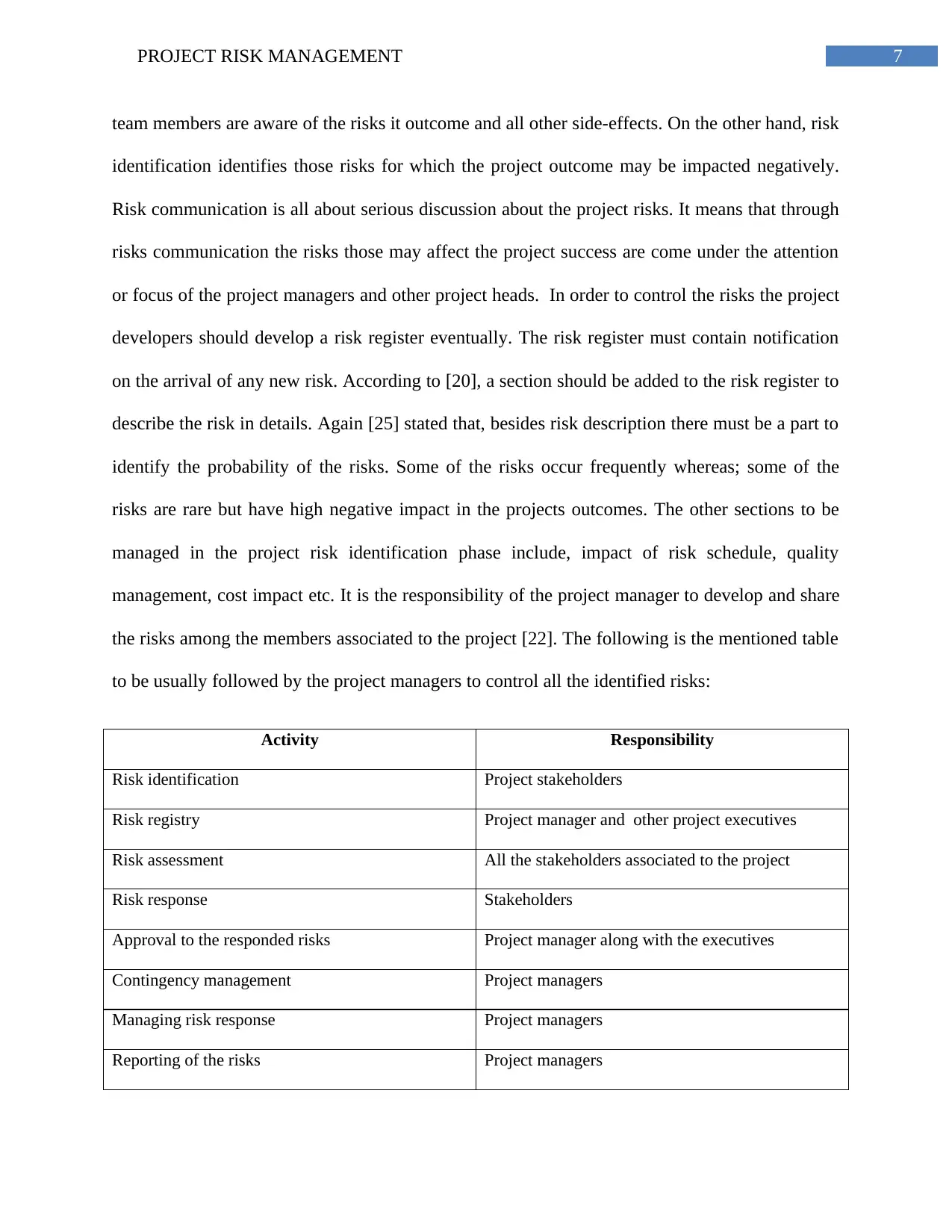
7PROJECT RISK MANAGEMENT
team members are aware of the risks it outcome and all other side-effects. On the other hand, risk
identification identifies those risks for which the project outcome may be impacted negatively.
Risk communication is all about serious discussion about the project risks. It means that through
risks communication the risks those may affect the project success are come under the attention
or focus of the project managers and other project heads. In order to control the risks the project
developers should develop a risk register eventually. The risk register must contain notification
on the arrival of any new risk. According to [20], a section should be added to the risk register to
describe the risk in details. Again [25] stated that, besides risk description there must be a part to
identify the probability of the risks. Some of the risks occur frequently whereas; some of the
risks are rare but have high negative impact in the projects outcomes. The other sections to be
managed in the project risk identification phase include, impact of risk schedule, quality
management, cost impact etc. It is the responsibility of the project manager to develop and share
the risks among the members associated to the project [22]. The following is the mentioned table
to be usually followed by the project managers to control all the identified risks:
Activity Responsibility
Risk identification Project stakeholders
Risk registry Project manager and other project executives
Risk assessment All the stakeholders associated to the project
Risk response Stakeholders
Approval to the responded risks Project manager along with the executives
Contingency management Project managers
Managing risk response Project managers
Reporting of the risks Project managers
team members are aware of the risks it outcome and all other side-effects. On the other hand, risk
identification identifies those risks for which the project outcome may be impacted negatively.
Risk communication is all about serious discussion about the project risks. It means that through
risks communication the risks those may affect the project success are come under the attention
or focus of the project managers and other project heads. In order to control the risks the project
developers should develop a risk register eventually. The risk register must contain notification
on the arrival of any new risk. According to [20], a section should be added to the risk register to
describe the risk in details. Again [25] stated that, besides risk description there must be a part to
identify the probability of the risks. Some of the risks occur frequently whereas; some of the
risks are rare but have high negative impact in the projects outcomes. The other sections to be
managed in the project risk identification phase include, impact of risk schedule, quality
management, cost impact etc. It is the responsibility of the project manager to develop and share
the risks among the members associated to the project [22]. The following is the mentioned table
to be usually followed by the project managers to control all the identified risks:
Activity Responsibility
Risk identification Project stakeholders
Risk registry Project manager and other project executives
Risk assessment All the stakeholders associated to the project
Risk response Stakeholders
Approval to the responded risks Project manager along with the executives
Contingency management Project managers
Managing risk response Project managers
Reporting of the risks Project managers
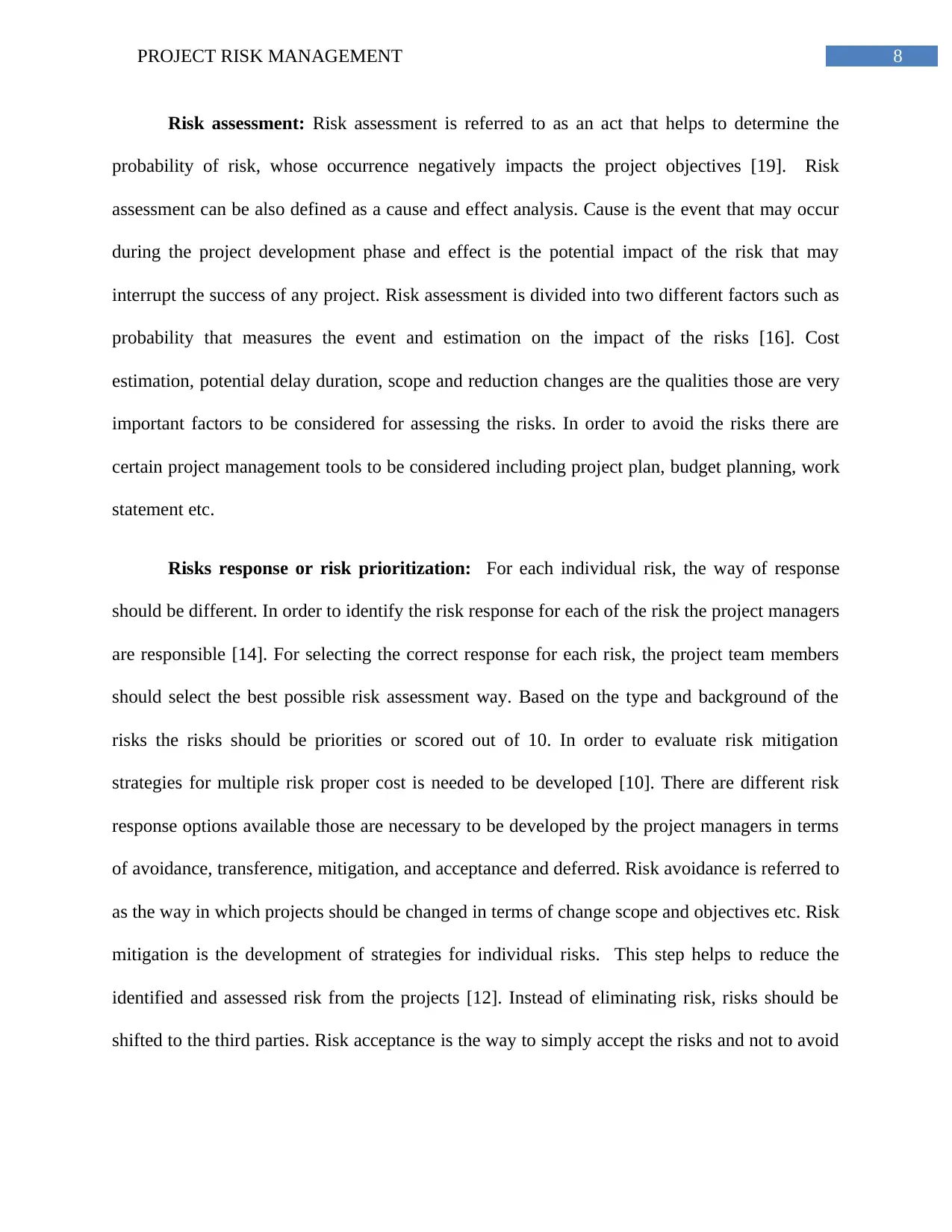
8PROJECT RISK MANAGEMENT
Risk assessment: Risk assessment is referred to as an act that helps to determine the
probability of risk, whose occurrence negatively impacts the project objectives [19]. Risk
assessment can be also defined as a cause and effect analysis. Cause is the event that may occur
during the project development phase and effect is the potential impact of the risk that may
interrupt the success of any project. Risk assessment is divided into two different factors such as
probability that measures the event and estimation on the impact of the risks [16]. Cost
estimation, potential delay duration, scope and reduction changes are the qualities those are very
important factors to be considered for assessing the risks. In order to avoid the risks there are
certain project management tools to be considered including project plan, budget planning, work
statement etc.
Risks response or risk prioritization: For each individual risk, the way of response
should be different. In order to identify the risk response for each of the risk the project managers
are responsible [14]. For selecting the correct response for each risk, the project team members
should select the best possible risk assessment way. Based on the type and background of the
risks the risks should be priorities or scored out of 10. In order to evaluate risk mitigation
strategies for multiple risk proper cost is needed to be developed [10]. There are different risk
response options available those are necessary to be developed by the project managers in terms
of avoidance, transference, mitigation, and acceptance and deferred. Risk avoidance is referred to
as the way in which projects should be changed in terms of change scope and objectives etc. Risk
mitigation is the development of strategies for individual risks. This step helps to reduce the
identified and assessed risk from the projects [12]. Instead of eliminating risk, risks should be
shifted to the third parties. Risk acceptance is the way to simply accept the risks and not to avoid
Risk assessment: Risk assessment is referred to as an act that helps to determine the
probability of risk, whose occurrence negatively impacts the project objectives [19]. Risk
assessment can be also defined as a cause and effect analysis. Cause is the event that may occur
during the project development phase and effect is the potential impact of the risk that may
interrupt the success of any project. Risk assessment is divided into two different factors such as
probability that measures the event and estimation on the impact of the risks [16]. Cost
estimation, potential delay duration, scope and reduction changes are the qualities those are very
important factors to be considered for assessing the risks. In order to avoid the risks there are
certain project management tools to be considered including project plan, budget planning, work
statement etc.
Risks response or risk prioritization: For each individual risk, the way of response
should be different. In order to identify the risk response for each of the risk the project managers
are responsible [14]. For selecting the correct response for each risk, the project team members
should select the best possible risk assessment way. Based on the type and background of the
risks the risks should be priorities or scored out of 10. In order to evaluate risk mitigation
strategies for multiple risk proper cost is needed to be developed [10]. There are different risk
response options available those are necessary to be developed by the project managers in terms
of avoidance, transference, mitigation, and acceptance and deferred. Risk avoidance is referred to
as the way in which projects should be changed in terms of change scope and objectives etc. Risk
mitigation is the development of strategies for individual risks. This step helps to reduce the
identified and assessed risk from the projects [12]. Instead of eliminating risk, risks should be
shifted to the third parties. Risk acceptance is the way to simply accept the risks and not to avoid
⊘ This is a preview!⊘
Do you want full access?
Subscribe today to unlock all pages.

Trusted by 1+ million students worldwide
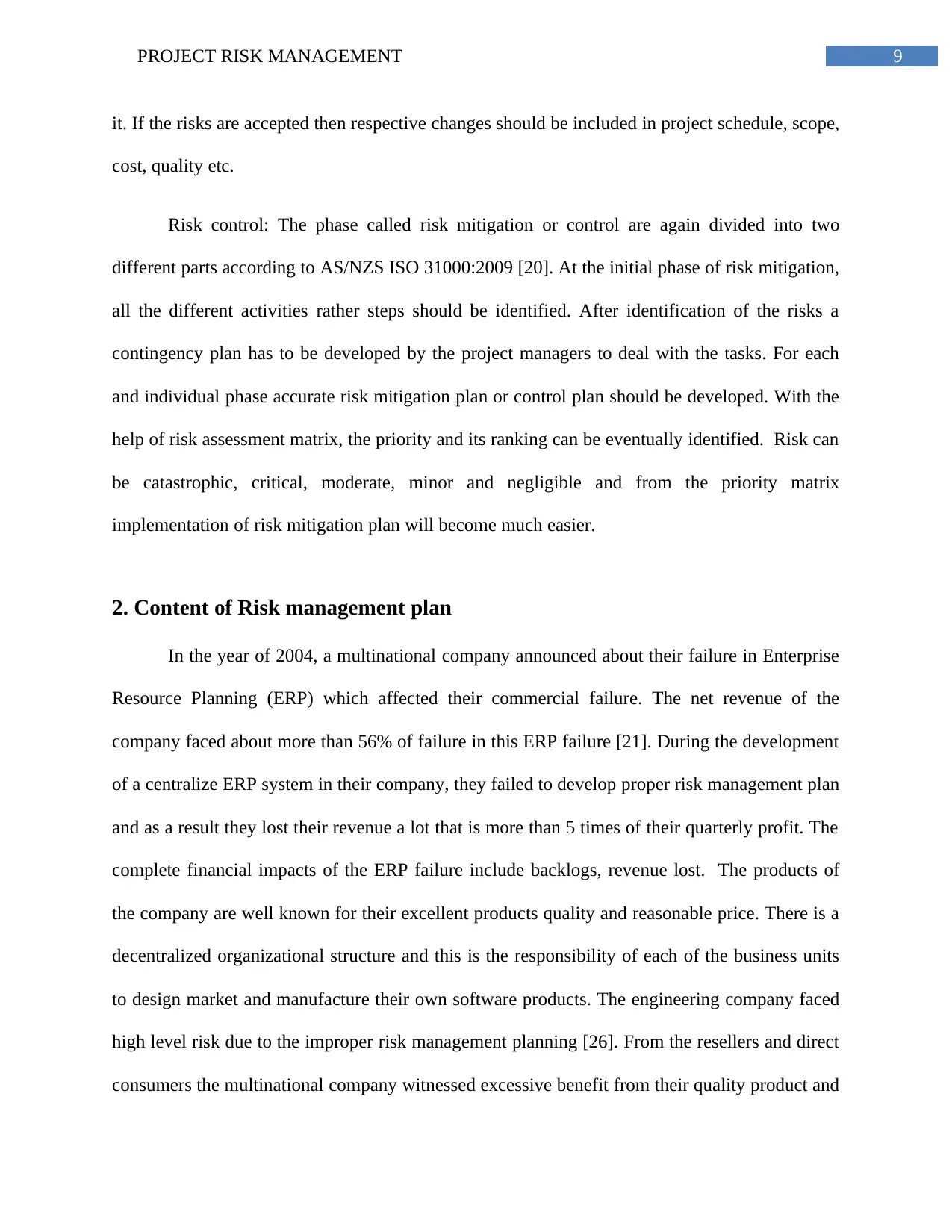
9PROJECT RISK MANAGEMENT
it. If the risks are accepted then respective changes should be included in project schedule, scope,
cost, quality etc.
Risk control: The phase called risk mitigation or control are again divided into two
different parts according to AS/NZS ISO 31000:2009 [20]. At the initial phase of risk mitigation,
all the different activities rather steps should be identified. After identification of the risks a
contingency plan has to be developed by the project managers to deal with the tasks. For each
and individual phase accurate risk mitigation plan or control plan should be developed. With the
help of risk assessment matrix, the priority and its ranking can be eventually identified. Risk can
be catastrophic, critical, moderate, minor and negligible and from the priority matrix
implementation of risk mitigation plan will become much easier.
2. Content of Risk management plan
In the year of 2004, a multinational company announced about their failure in Enterprise
Resource Planning (ERP) which affected their commercial failure. The net revenue of the
company faced about more than 56% of failure in this ERP failure [21]. During the development
of a centralize ERP system in their company, they failed to develop proper risk management plan
and as a result they lost their revenue a lot that is more than 5 times of their quarterly profit. The
complete financial impacts of the ERP failure include backlogs, revenue lost. The products of
the company are well known for their excellent products quality and reasonable price. There is a
decentralized organizational structure and this is the responsibility of each of the business units
to design market and manufacture their own software products. The engineering company faced
high level risk due to the improper risk management planning [26]. From the resellers and direct
consumers the multinational company witnessed excessive benefit from their quality product and
it. If the risks are accepted then respective changes should be included in project schedule, scope,
cost, quality etc.
Risk control: The phase called risk mitigation or control are again divided into two
different parts according to AS/NZS ISO 31000:2009 [20]. At the initial phase of risk mitigation,
all the different activities rather steps should be identified. After identification of the risks a
contingency plan has to be developed by the project managers to deal with the tasks. For each
and individual phase accurate risk mitigation plan or control plan should be developed. With the
help of risk assessment matrix, the priority and its ranking can be eventually identified. Risk can
be catastrophic, critical, moderate, minor and negligible and from the priority matrix
implementation of risk mitigation plan will become much easier.
2. Content of Risk management plan
In the year of 2004, a multinational company announced about their failure in Enterprise
Resource Planning (ERP) which affected their commercial failure. The net revenue of the
company faced about more than 56% of failure in this ERP failure [21]. During the development
of a centralize ERP system in their company, they failed to develop proper risk management plan
and as a result they lost their revenue a lot that is more than 5 times of their quarterly profit. The
complete financial impacts of the ERP failure include backlogs, revenue lost. The products of
the company are well known for their excellent products quality and reasonable price. There is a
decentralized organizational structure and this is the responsibility of each of the business units
to design market and manufacture their own software products. The engineering company faced
high level risk due to the improper risk management planning [26]. From the resellers and direct
consumers the multinational company witnessed excessive benefit from their quality product and
Paraphrase This Document
Need a fresh take? Get an instant paraphrase of this document with our AI Paraphraser
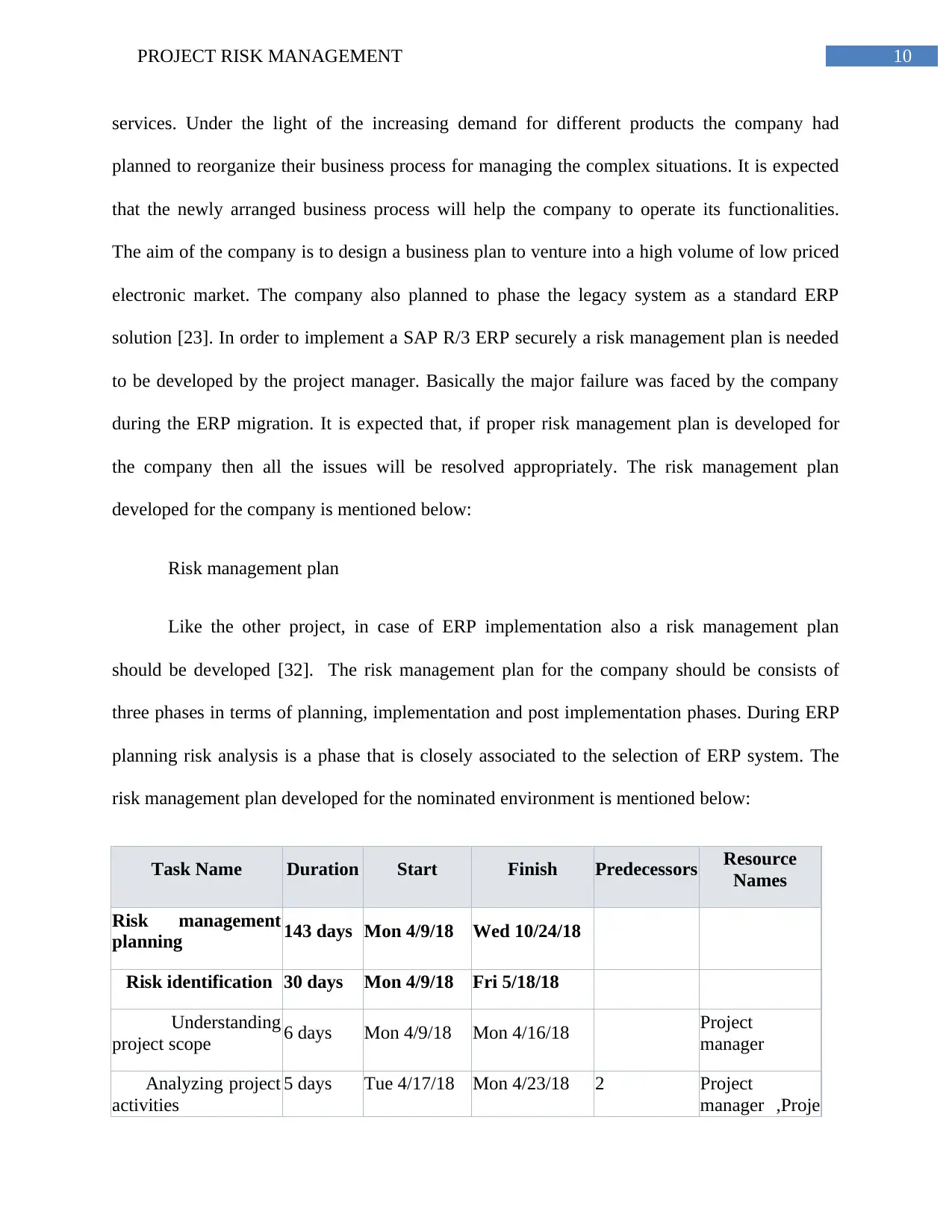
10PROJECT RISK MANAGEMENT
services. Under the light of the increasing demand for different products the company had
planned to reorganize their business process for managing the complex situations. It is expected
that the newly arranged business process will help the company to operate its functionalities.
The aim of the company is to design a business plan to venture into a high volume of low priced
electronic market. The company also planned to phase the legacy system as a standard ERP
solution [23]. In order to implement a SAP R/3 ERP securely a risk management plan is needed
to be developed by the project manager. Basically the major failure was faced by the company
during the ERP migration. It is expected that, if proper risk management plan is developed for
the company then all the issues will be resolved appropriately. The risk management plan
developed for the company is mentioned below:
Risk management plan
Like the other project, in case of ERP implementation also a risk management plan
should be developed [32]. The risk management plan for the company should be consists of
three phases in terms of planning, implementation and post implementation phases. During ERP
planning risk analysis is a phase that is closely associated to the selection of ERP system. The
risk management plan developed for the nominated environment is mentioned below:
Task Name Duration Start Finish Predecessors Resource
Names
Risk management
planning 143 days Mon 4/9/18 Wed 10/24/18
Risk identification 30 days Mon 4/9/18 Fri 5/18/18
Understanding
project scope 6 days Mon 4/9/18 Mon 4/16/18 Project
manager
Analyzing project
activities
5 days Tue 4/17/18 Mon 4/23/18 2 Project
manager ,Proje
services. Under the light of the increasing demand for different products the company had
planned to reorganize their business process for managing the complex situations. It is expected
that the newly arranged business process will help the company to operate its functionalities.
The aim of the company is to design a business plan to venture into a high volume of low priced
electronic market. The company also planned to phase the legacy system as a standard ERP
solution [23]. In order to implement a SAP R/3 ERP securely a risk management plan is needed
to be developed by the project manager. Basically the major failure was faced by the company
during the ERP migration. It is expected that, if proper risk management plan is developed for
the company then all the issues will be resolved appropriately. The risk management plan
developed for the company is mentioned below:
Risk management plan
Like the other project, in case of ERP implementation also a risk management plan
should be developed [32]. The risk management plan for the company should be consists of
three phases in terms of planning, implementation and post implementation phases. During ERP
planning risk analysis is a phase that is closely associated to the selection of ERP system. The
risk management plan developed for the nominated environment is mentioned below:
Task Name Duration Start Finish Predecessors Resource
Names
Risk management
planning 143 days Mon 4/9/18 Wed 10/24/18
Risk identification 30 days Mon 4/9/18 Fri 5/18/18
Understanding
project scope 6 days Mon 4/9/18 Mon 4/16/18 Project
manager
Analyzing project
activities
5 days Tue 4/17/18 Mon 4/23/18 2 Project
manager ,Proje
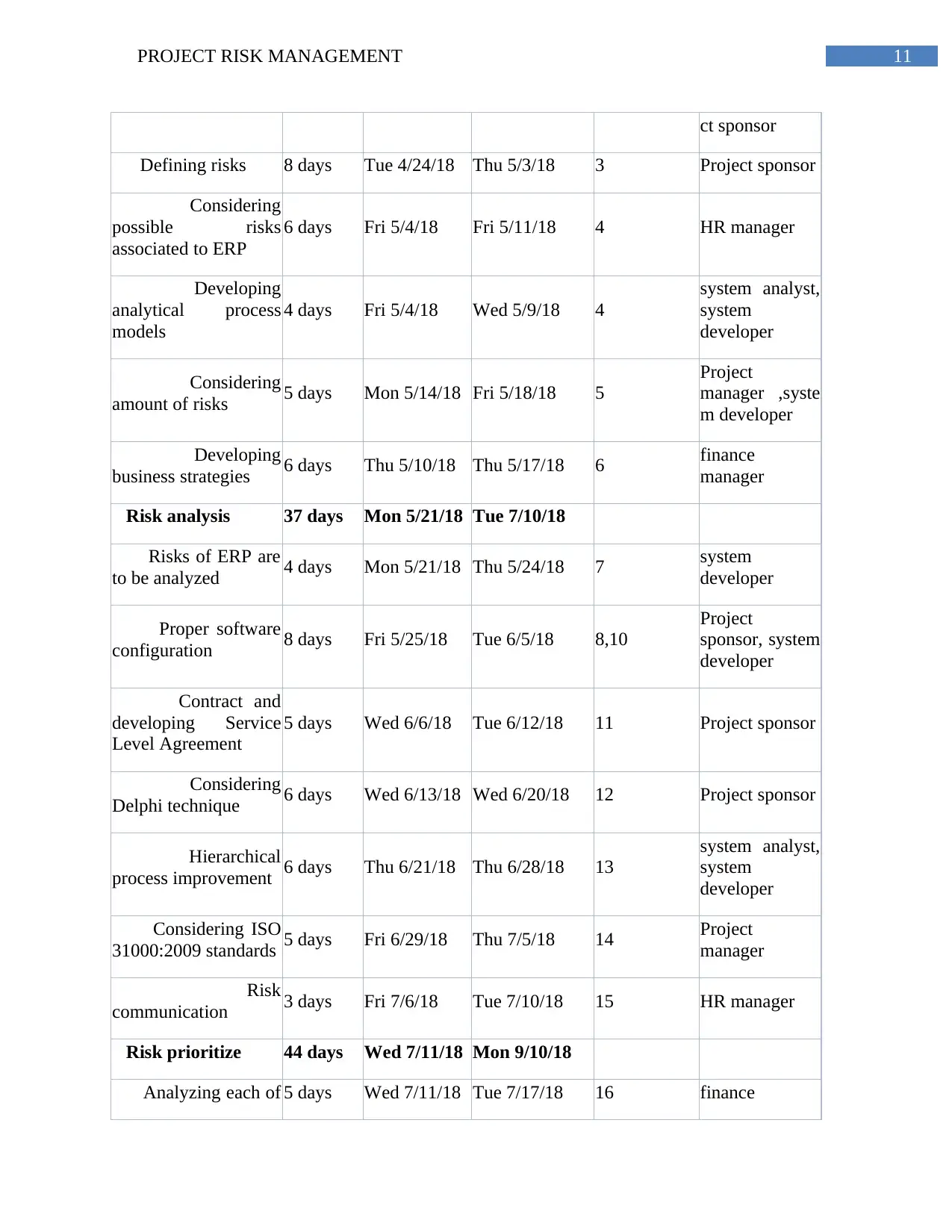
11PROJECT RISK MANAGEMENT
ct sponsor
Defining risks 8 days Tue 4/24/18 Thu 5/3/18 3 Project sponsor
Considering
possible risks
associated to ERP
6 days Fri 5/4/18 Fri 5/11/18 4 HR manager
Developing
analytical process
models
4 days Fri 5/4/18 Wed 5/9/18 4
system analyst,
system
developer
Considering
amount of risks 5 days Mon 5/14/18 Fri 5/18/18 5
Project
manager ,syste
m developer
Developing
business strategies 6 days Thu 5/10/18 Thu 5/17/18 6 finance
manager
Risk analysis 37 days Mon 5/21/18 Tue 7/10/18
Risks of ERP are
to be analyzed 4 days Mon 5/21/18 Thu 5/24/18 7 system
developer
Proper software
configuration 8 days Fri 5/25/18 Tue 6/5/18 8,10
Project
sponsor, system
developer
Contract and
developing Service
Level Agreement
5 days Wed 6/6/18 Tue 6/12/18 11 Project sponsor
Considering
Delphi technique 6 days Wed 6/13/18 Wed 6/20/18 12 Project sponsor
Hierarchical
process improvement 6 days Thu 6/21/18 Thu 6/28/18 13
system analyst,
system
developer
Considering ISO
31000:2009 standards 5 days Fri 6/29/18 Thu 7/5/18 14 Project
manager
Risk
communication 3 days Fri 7/6/18 Tue 7/10/18 15 HR manager
Risk prioritize 44 days Wed 7/11/18 Mon 9/10/18
Analyzing each of 5 days Wed 7/11/18 Tue 7/17/18 16 finance
ct sponsor
Defining risks 8 days Tue 4/24/18 Thu 5/3/18 3 Project sponsor
Considering
possible risks
associated to ERP
6 days Fri 5/4/18 Fri 5/11/18 4 HR manager
Developing
analytical process
models
4 days Fri 5/4/18 Wed 5/9/18 4
system analyst,
system
developer
Considering
amount of risks 5 days Mon 5/14/18 Fri 5/18/18 5
Project
manager ,syste
m developer
Developing
business strategies 6 days Thu 5/10/18 Thu 5/17/18 6 finance
manager
Risk analysis 37 days Mon 5/21/18 Tue 7/10/18
Risks of ERP are
to be analyzed 4 days Mon 5/21/18 Thu 5/24/18 7 system
developer
Proper software
configuration 8 days Fri 5/25/18 Tue 6/5/18 8,10
Project
sponsor, system
developer
Contract and
developing Service
Level Agreement
5 days Wed 6/6/18 Tue 6/12/18 11 Project sponsor
Considering
Delphi technique 6 days Wed 6/13/18 Wed 6/20/18 12 Project sponsor
Hierarchical
process improvement 6 days Thu 6/21/18 Thu 6/28/18 13
system analyst,
system
developer
Considering ISO
31000:2009 standards 5 days Fri 6/29/18 Thu 7/5/18 14 Project
manager
Risk
communication 3 days Fri 7/6/18 Tue 7/10/18 15 HR manager
Risk prioritize 44 days Wed 7/11/18 Mon 9/10/18
Analyzing each of 5 days Wed 7/11/18 Tue 7/17/18 16 finance
⊘ This is a preview!⊘
Do you want full access?
Subscribe today to unlock all pages.

Trusted by 1+ million students worldwide
1 out of 34
Related Documents
Your All-in-One AI-Powered Toolkit for Academic Success.
+13062052269
info@desklib.com
Available 24*7 on WhatsApp / Email
![[object Object]](/_next/static/media/star-bottom.7253800d.svg)
Unlock your academic potential
Copyright © 2020–2025 A2Z Services. All Rights Reserved. Developed and managed by ZUCOL.





